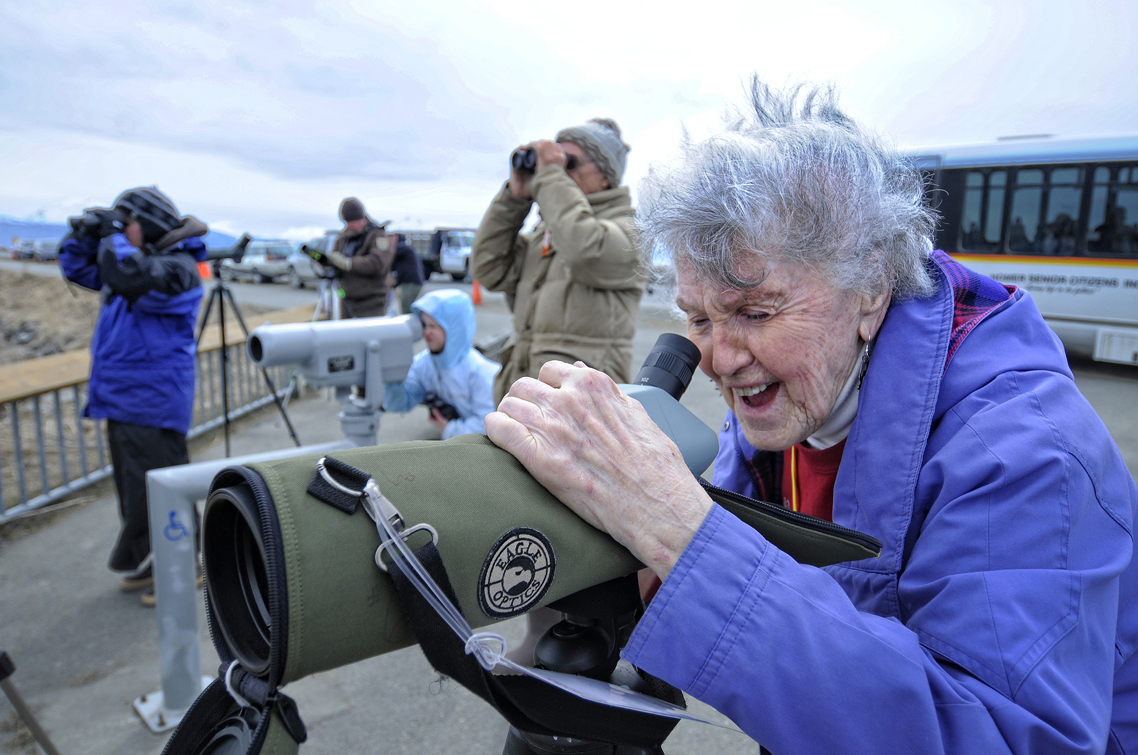Yes, indeed, there is a Kachemak Bay Shorebird Festival (see related story, page 1). The arrival of winged visitors from the tip of South America, Central America and all along the Pacific Coast as they make their way to northern nesting grounds is cause for more than a festival, however. It marks an opportunity for important citizen science with significance beyond the present day and beyond Kachemak Bay.
“That’s where the two Georges play a role in this whole thing. They’re probably doing the best citizen science survey along the whole Pacific Coast that I know about,” said Dr. Richard Lanctot, Region 7 shorebird coordinator for the U.S. Fish and Wildlife Service in Anchorage.
The Georges Lanctot is talking about are Homer resident George Matz and former Homer resident George West.
Matz has a degree in biology from Northern Illinois University. He moved to the Homer area 10 years ago, heads up the Kachemak Bay shorebird monitoring project and currently serves as chair of the Kachemak Bay Research Reserve Community Council and as a board member of the Kachemak Bay Conservation Society.
West holds a doctoral degree from the University of Illinois Champaign-Urbana in physiological ecology. He taught ornithology, ecology, general biology and comparative anatomy at the University of Rhode Island and helped form the Institute of Arctic Biology at the University of Alaska Fairbanks. After retiring, West moved to Homer in 1984. Since 1996, he has enjoyed birding in Arizona.
During his career, birding research took West to Russia, Sweden, Norway and Poland. While helping develop UAF’s Institute of Arctic Biology, he was involved in additional research in the Cordova area. After moving to Homer, he launched an effort to develop a baseline of shorebirds in the area.
“We started doing that every spring in May, just walking down the Spit, on both sides, and counting all the birds we saw. We did that every day for the month of May,” West told the Homer News in a phone interview last week.
He shared his observations in a newsletter format with a handful of subscribers.
“The newsletter sparked interest among people in Homer and with all the data we had, we knew the birds were going to come every spring at some point in the first few weeks in May,” he said.
In 1992, the idea of a shorebird festival was suggested by Poppy Benson who, at that time, was with USFWS and served on the Homer Chamber of Commerce’s tourism committee. Benson envisioned a festival as a way to expand Homer’s tourist season, focus attention on shorebirds and discourage the Homer City Council from increasing Mariner Park’s space for RVs by filling in Mariner Park lagoon.
“It worked perfectly,” Benson said of the festival’s success in all three areas.
West’s focus was more scientific than social.
“(Developing a baseline) is really important in any work like this,” he said. “If you want to be scientific and say this species has gone up or down in number over time, you’ve got to get a baseline.”
Matz was aware of West’s work. After moving to Homer, he wanted to revive the efforts and, in 2008, began Kachemak Bay Birders.
“With (West’s) observations, we had an opportunity to compare current results with about two decades ago and it shows a substantial change,” said Matz.
Some species indicate increased numbers, but there has been on overall decline.
“When (West) was here, he did this daily survey during the peak migration of how many shorebirds he’d see out there and then also looked at the Fox River Flats and other intertidal areas where there were concentrations (of birds) and people were seeing hundreds of thousands at that time,” said Matz. “We see thousands now, but not the numbers they used to.”
Serving in an advisory-type role, Lanctot helps connect the local bird-count effort with the bigger picture.
“I’m interested in shorebirds overall and mostly the status and trends in populations, seeing how they’re doing. One way is counting birds along the migration route to see how those numbers are changing year to year and through time,” said Lanctot. “What you need is people like the Georges in many communities. They’re the ones that get it going, keep it going and you just don’t have many people like that.”
The Georges are aware Kachemak Bay shorebird surveys are one piece of a larger puzzle.
“I think we probably will learn something about the effect of development on nature and wildlife in general,” said West.
“These birds go back and forth every year, down to California, some of them on down to South America. Those habitats are all gradually being developed, filled in and one thing or another. With the habitat gone, the number of shorebirds able to be sustained decreases. The nesting habitat is in Western and Northern Alaska where there aren’t any significant changes in habitat loss, so it’s not there that the problems exists,” West continued.
Matz recognized the local surveys make “a contribution on an international scale. So, we’re gathering a lot of data probably beyond us to put it all together, but unless you have this network going, you just never get anywhere.”
For more about Kachemak Bay Birders, visit kachemakbaybirders.org.
Kachemak Bay Shorebird Festival: small piece of big puzzle



